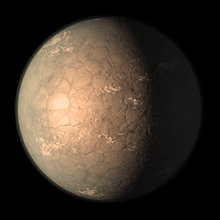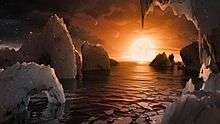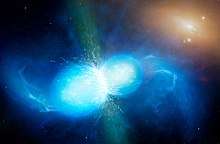TRAPPIST-1g
TRAPPIST-1g, also designated as 2MASS J23062928-0502285 g, is an exoplanet orbiting around the ultra-cool dwarf star TRAPPIST-1 39 light-years (12 parsecs) away from Earth in the constellation Aquarius. It was one of four new exoplanets to be discovered orbiting the star using observations from the Spitzer Space Telescope.[4] The exoplanet is within the optimistic habitable zone of its host star.[5] It was found by using the transit method, in which the dimming effect that a planet causes as it crosses in front of its star is measured.
 Artist's impression of TRAPPIST-1g. (February 2018) | |
| Discovery | |
|---|---|
| Discovery date | 2017 |
| Transit | |
| Orbital characteristics | |
| Apastron | 0.04697 +0.0000031 −0.000004 AU |
| Periastron | 0.04678 +0.0000034 −0.000004 AU |
| 0.04687692 ± 3.2e−07[1] AU | |
| Eccentricity | 0.00208 (± 0.00058)[1] |
| 12.424305 (± 0.00000039)[1] d | |
| Inclination | 89.721 (± 0.23)[2] |
| Star | TRAPPIST-1[3] |
| Physical characteristics | |
Mean radius | 1.148 +0.032 −0.033[1] R⊕ |
| Mass | 1.148 +0.098 −0.095[1] M⊕ |
Mean density | 4.186 +0.187 −0.182 g/cm3 |
| 0.871 +0.040 −0.039[1] g | |
| Temperature | 194.5 ± 2.7 K (−78.65 ± 2.70 °C; −109.57 ± 4.86 °F) (equilibrium)[2] |
The second most distant known planet in its system, TRAPPIST-1g is a planet larger than Earth yet less dense, meaning it likely hosts some form of water.
Characteristics
Mass, radius, and temperature
TRAPPIST-1g has roughly 115% the mass and radius of Earth, though its density is only 4.186 g/cm3, about 76% of Earth's. Based on mass-radius calculations and its distant location relative to its host star, and the fact that the planet only receives 25% of the stellar flux that Earth does, the planet is likely covered by a thick ice envelope, though theoretically it could be a global water ocean or an exceptionally thick atmosphere.[1]
Host star
The planet orbits an (M-type) ultracool dwarf star named TRAPPIST-1. The star has a mass of 0.08 M☉ and a radius of 0.11 R☉. It has a temperature of 2550 K and is at least 500 million years old. In comparison, the Sun is 4.6 billion years old and has a temperature of 5778 K. The star is metal-rich, with a metallicity ([Fe/H]) of 0.04, or 109% the solar amount. This is particularly odd as such low-mass stars near the boundary between brown dwarfs and hydrogen-fusing stars should be expected to have considerably less metal content than the Sun. Its luminosity (L☉) is 0.05% of that of the Sun.
The star's apparent magnitude, or how bright it appears from Earth's perspective, is 18.8, too dim to be seen with the naked eye.
Orbit
TRAPPIST-1g orbits its host star with an orbital period of about 12.354 days and an orbital radius of about 0.0451 times that of Earth's (compared to the distance of Mercury from the Sun, which is about 0.38 AU). This is in the outer limit of TRAPPIST-1's theoretical habitable zone. The orbit of TRAPPIST-1g has an eccentricity of 0.00208,[1] much lower than that of Earth and the lowest in its system. Its orbit varies by only about 41,000 kilometers (compared to about 5 million km for Earth), meaning the planet's climate is likely very stable. It is in a 3:2 orbital resonance with TRAPPIST-1h and a 3:4 resonance with TRAPPIST-1f.
Water
On 31 August 2017, astronomers at the Hubble Space Telescope reported the first evidence of possible water content on the TRAPPIST-1 exoplanets.[6][7]
See also
- List of extrasolar candidates for liquid water
- List of transiting exoplanets
- List of potentially habitable exoplanets
- List of nearest terrestrial exoplanet candidates
- Other Habitable Zone planets of the TRAPPIST-1 system:
References
- Grimm, Simon L.; Demory, Brice-Olivier; Gillon, Michael; Dorn, Caroline; Agol, Eric; Burdanov, Artem; Delrez, Laetitia; Sestovic, Marko; Triaud, Amaury H.M.J.; Turbet, Martin; Bolmont, Emeline; Caldas, Anthony; de Wit, Julien; Jehin, Emmanuel; Leconte, Jeremy; Raymond, Sean N.; Van Grootel, Valerie; Burgasser, Adam J.; Carey, Sean; Fabrycky, Daniel; Heng, Kevin; Hernandez, David M.; Ingalls, James G.; Lederer, Susan; Selsis, Franck; Queloz, Didier (2018). "The nature of the TRAPPIST-1 exoplanets". Astronomy & Astrophysics. 613: A68. arXiv:1802.01377. doi:10.1051/0004-6361/201732233.
- Delrez, Laetitia; Gillon, Michael; H.M.J, Amaury; Brice-Oliver Demory, Triaud; de Wit, Julien; Ingalls, James; Agol, Eric; Bolmont, Emeline; Burdanov, Artem; Burgasser, Adam J.; Carey, Sean J.; Jehin, Emmanuel; Leconte, Jeremy; Lederer, Susan; Queloz, Didier; Selsis, Franck; Grootel, Valerie Van (2018). "Early 2017 observations of TRAPPIST-1 with Spitzer". Monthly Notices of the Royal Astronomical Society. 475 (3): 3577–3597. arXiv:1801.02554. doi:10.1093/mnras/sty051.
- Van Grootel, Valerie; Fernandes, Catarina S.; Gillon, Michaël; Jehin, Emmanuel; Scuflaire, Richard; et al. (2018). "Stellar parameters for TRAPPIST-1". The Astrophysical Journal. 853: 30. arXiv:1712.01911. doi:10.3847/1538-4357/aaa023.
- "Temperate Earth-Sized Planets Found in Extraordinarily Rich Planetary System TRAPPIST-1". SpaceRef. 22 February 2017. Retrieved 11 February 2017.
- "NASA telescope reveals largest batch of Earth-size, habitable-zone planets around single star". Exoplanet Exploration: Planets Beyond our Solar System (Press release). Retrieved 22 February 2017.
- Bourrier, Vincent; de Wit, Julien; Jäger, Mathias (31 August 2017). "Hubble delivers first hints of possible water content of TRAPPIST-1 planets". www.SpaceTelescope.org. Retrieved 4 September 2017.
- PTI (4 September 2017). "First evidence of water found on TRAPPIST-1 planets - The results suggest that the outer planets of the system might still harbour substantial amounts of water. This includes the three planets within the habitable zone of the star, lending further weight to the possibility that they may indeed be habitable". The Indian Express. Retrieved 4 September 2017.



